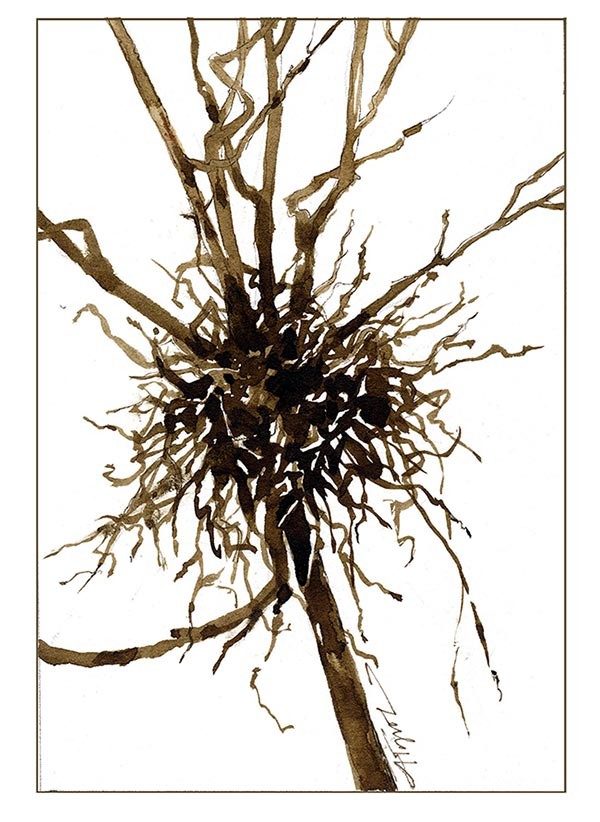
Harry Potter rode one during the Quidditch matches at Hogwarts. The Wicked Witch of the West zipped around on one in the Wizard of Oz.
We’re talking, of course, about witch’s brooms. No one knows exactly why witches were associated with with flying brooms. But the trope is remarkably persistent. The witch is the perennial favorite in Halloween costume popularity rankings, and she always carries a broom, generally a twiggy bundle with a handle that doesn’t look like it would do much for a floor.
But there’s another type of witch’s broom. This one grows on trees, or, more specifically, from the tree. It’s a tightly-packed mass of shoots, a deformity caused by organisms that have invaded the tree, or a genetic mutation.
In a way, witch’s brooms are like burls, those swellings of the trunk of a tree that produce nicely figured wood. Burls are produced when an organism invades the straw-like pathways in the phloem, or inner layer of bark.
Witches brooms occur when an organism attacks the apical buds of a tree – the growing tips – causing a “disruption of the normal growth regulators, especially auxin, which turns off or slows down the growth of buds that are away from the tip,” said Kevin Smith, the supervisory plant physiologist at the U.S. Forest Service’s Northern Research Station in Durham, New Hampshire.
Smith explained that the infection stimulates the production of cytokinin, a plant hormone that interferes with auxin’s ability to regulate the number of shoots on the twig or branch. The cytokinin causes shoots to proliferate wildly, producing a shrubby little tree within a tree.
There are many causes of witch’s brooms, including fungi, insects, mistletoe and dwarf mistletoe, tiny mites, viruses, and phytoplasmas – specialized bacteria that are parasites of both their transmitting organism and of the tree.
Many species of trees and shrubs, both hardwoods and softwoods, are susceptible to brooming. Smith has seen them on butternut, black walnut, lilacs, hackberry, fir, serviceberry, and other species. In my garden I find them on my high bush blueberries, where they proliferate but don’t bear any fruit. I cut them out, but they tend to grow back. That’s because the organism that caused the growth in the first place (in this case, probably rust) has already spread throughout the bush.
It’s said that witch’s brooms got their name because people thought witches had flown over the tree, or stopped to rest there. As a boy, I hadn’t heard that tale. I called these growths “squirrel nests.” Not because I ever saw a squirrel in them, but because they looked like squirrels should nest in them. It turns out that I wasn’t wrong. The northern flying squirrel, as well as some birds, do use them for shelter. This specialized habitat is also used by some insects, Smith told me.
There’s also another plus to witch’s brooms. Since each is genetically unique, some horticulturists collect them in hopes of perpetuating the genetic disruption caused in the parent tree, to create a new cultivar. It’s not a hobby for the fearful – or the acrophobic -– you have to climb the tree to harvest the broom. In some cases a ruder tool is employed: a shotgun or a chain saw.
Some witch’s brooms have pernicious economic effects. One witch’s broom disease caused by a fungus attacks the cocoa tree that produces chocolate. The fungus’s spores are spread by wind. It is expensive to control and can have a drastic effect on production. After the disease found its way to Brazil’s cocoa-producing Bahia State in the late 1990s, the country went from being second in the world in cocoa production to a net importer.
“It is a major threat to chocolate production in parts of the tropics,” said Smith. “It’s definitely a no-joke disease and a driver of research on witch’s brooming.” A witch’s broom that affects lime trees, threatens the citrus industry in portions of the world.
Most witch’s brooms, however, don’t appear to weaken their host plant. Many trees live with them – sometimes dozens of them – for decades. These twiggy masses, said Smith, are another example of “the intimacy of the relationships among different groups of organisms that have been living together for a very long time.”


Discussion *